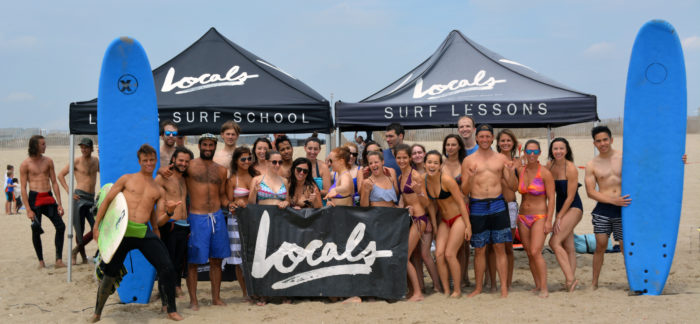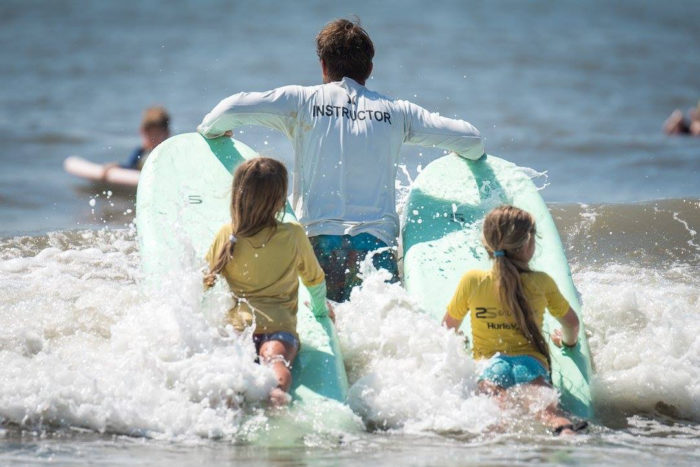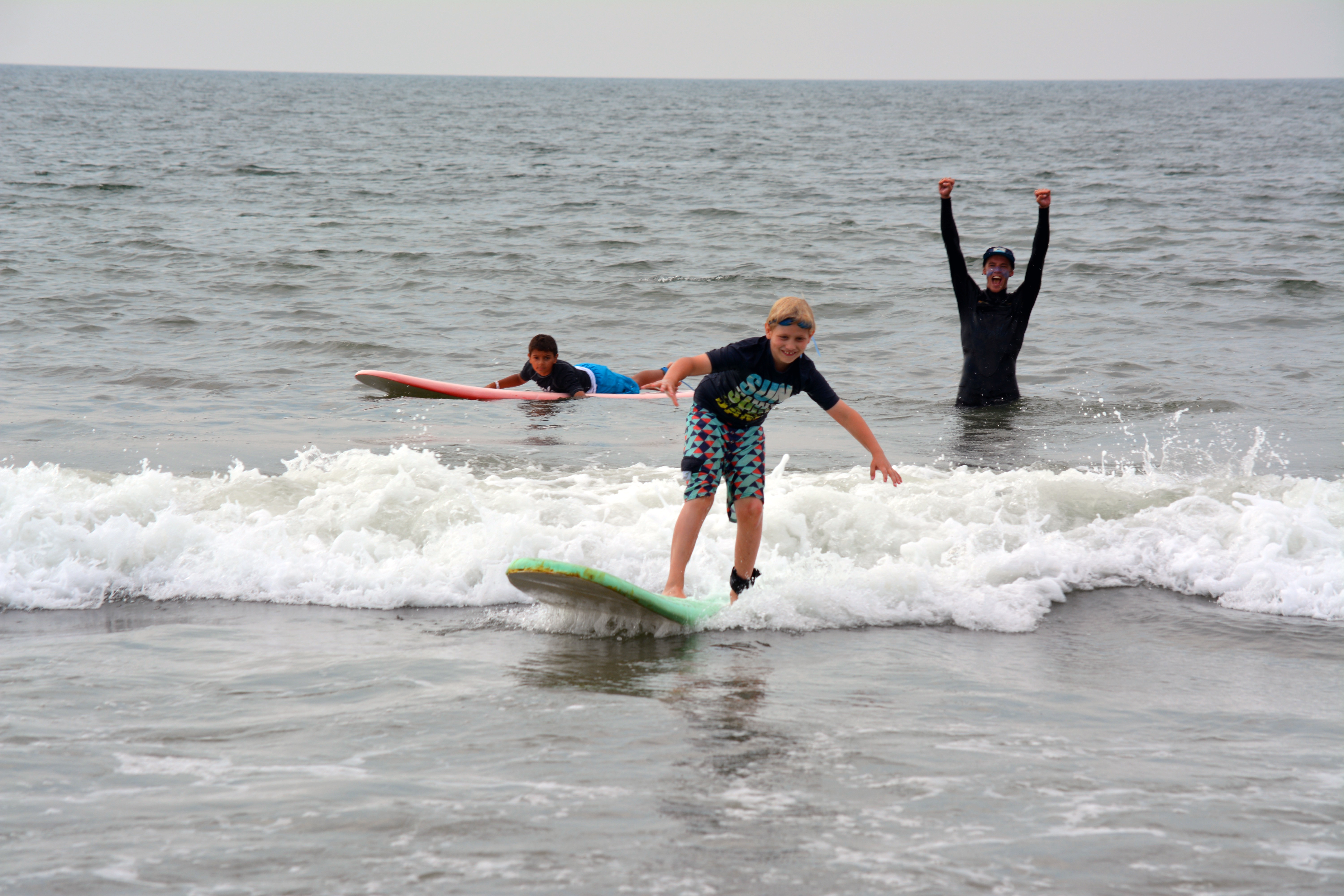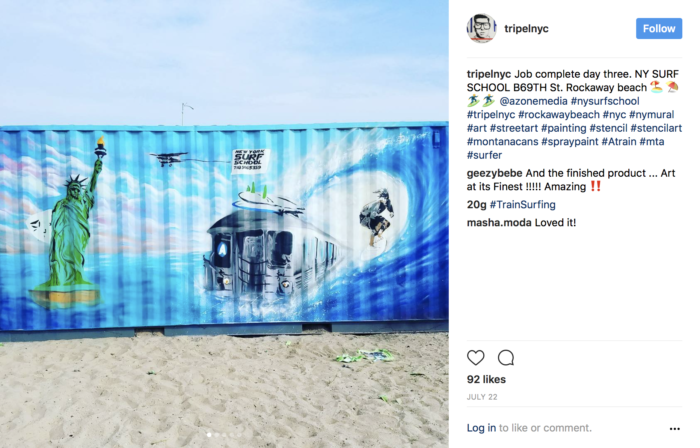On bus shelters in Brooklyn this summer, tantalizing advertisements popped up, asking, “Did you know that in about 45 minutes from where you are standing, you could swipe your MetroCard, jump on the subway, and be SURFING?” Intrigued, we asked Rockaways journalist Claudia Bloom to report on the budding business of surf school. (While the beaches of the Rockaways are officially in Queens, Brooklynites have increasingly claimed them as their seaside backyard.) Her report:
On a bright summer morning, armed with my iced coffee and slathered with sunscreen, my work uniform a bikini, tank top, flip flops and a sun hat, I approached the trio of surf-school tents between Beach 67th and Beach 69th streets. After six years of mostly self-taught surfing in the Rockaways, and as a recent “expat” surfer from Manhattan, I’ve witnessed the growth of these schools and wondered: Can they teach all levels of surfers? And where are their students coming from?
The activity around New York Surf School’s light-blue tent was buzzing as students began to arrive and the staff was preparing them with longboard “foamies” for beginners and rash-guard shirts to protect their skin from contact with the board. No wetsuits were necessary, with the ocean temperature at an inviting mid to high 70s.

The Locals Surf School, founded by two guys named Mike, offer lessons as well as camps (Photo courtesy of Locals Surf School)
The school’s founder, Frank Cullen, his face covered with white zinc, sat down with me. Most surfers you meet on the waves are young adults, but Cullen goes back decades in his surf journey. “Anything I learned about the ocean I learned here,” in the Rockaways, he said. Cullen learned to surf at 18 and quickly began driving a 1985 Cadillac with several boards strapped on top. He opened his surf school in Rockaway in 2006 as a one-man show.
This was before today’s surfing boom. At the time, only locals and high-level surfers were riding here. The idea of beginners coming out from the city to break into the sport was a novelty. Cullen started to build interest by word of mouth, first with adult customers, then children, and now summer camps.
The demographics of his student surfers? About two thirds are women and about 60% are Brooklynites, says Cullen. Yes, the millennials do flock from the trendier neighborhoods of Williamsburg, Greenpoint and Bushwick, but a big part of the business is kids venturing out for surf camp from Park Slope, Brooklyn Heights and Windsor Terrace.
Cullen runs the operation year round with a staff of experienced instructors, many of whom started as his students, as well as high-school kids as junior instructors. All of them are paid by the session. The school’s busiest season, of course, is summer, when they teach about 1,500 students. Lessons start at $110 for a one-hour private class, increasing with additional time and fluctuating based on package deals (the most popular class is the two-hour group lesson for $90). Boards are provided, ranging from a 5-foot-8 shortboard to a 10-foot longboard, based on the student’s height, weight and experience level.

An instructor for Skudin Surf gives students a tow into the waves (Photo by Shaun Cleary/Courtesy of Skudin Surf)
To Cullen, “surfing is a lifestyle, not a sport,” by which he means a holistic approach is necessary. He puts his students on the right equipment, shows them how to read a wave and line up properly, and demonstrates how to fall safely, he says. “You should never get hurt landing in water.”
Cullen promotes his school through social media, Yelp and those Brooklyn bus-station ads, but having the critical mass of a small industry on the beach attracts attention too. “We are blessed to have three excellent, well-rounded schools right here,” he said.
 Tips & Takeaways
Tips & Takeaways
- Locals Surf School can be reached at (347) 752-2728 between 8 a.m. and 8 p.m. or text that number at any time. For email inquiries, the address is info@localssurfschool.com
- New York Surf School’s number for calling or texting is (718) 916-5359. The school gives lessons seven days a week starting at 9 a.m., with early bird lessons at 7 a.m. on weekends
- Skudin Surf’s number is (516) 318-3993 and the office is open from 7 a.m. to 7 p.m., seven days a week. For information, send emails to lessons@skudinsurf.com
The next color-coded tent to visit was the light brown one, where Jeff Anthony is the director of operations of Skudin Surf in Rockaway. His “rad” style is well-recognized in the surf community. As another local native, Anthony came to surfing at age 10. He was a competitive swimmer in Long Beach and befriended a pair of fellow swimmers, the Skudin brothers, who came from a family of surf enthusiasts. The Skudins began their business in Long Beach in 2007 and now they also have a presence in Atlantic Beach and Lido, as well as Rockaway.
While Anthony competes in national events, his passion for teaching–especially to kids–is clear. His youngest memory of surfing was going far out on waves, as a strong swimmer with no fear, and his mom nervously telling his dad, “he’s too far out.” Anthony’s dad took up surfing to keep an eye on his son.
Skudin Surf is seasonal in Rockaway, running from May to early fall, at which point they decamp to run a winter school and shop in Rincon, Puerto Rico. The Rockaway arm employs about 10 instructors and four other staffers, all paid hourly. A private, 75-minute lesson is $100; semi-private and group lessons reduce the cost. They operate surf camps for both children and adults, averaging 50 to 80 students per week.

A teacher gives positive reinforcement as a student lands his “pop up” (Photo courtesy of Locals Surf School)
Anthony’s oldest student was a woman named Margaret, age 80, who signed up for the one-week summer camp. It was four hours a day and she never missed a moment, Anthony recalls. On the final day, he presented her with the “determination and dedication award” and asked all the students to “give it up for Margaret!”
The Skudin approach is a fun but professional one, focusing on the fundamentals, and Anthony admits he’s famous for “overteaching.” Before he got back to his students, he asked to see my “pop up,” the move to a standing position. For the next 10 minutes on land, he deconstructed my technique, recommending that I reposition my back foot farther towards the tail of the board. He might be overteaching, but it worked like a dream on three small waves later that day.
The third school in the local trio is the Locals Surf School, owned by Michael Kololyan and Michael Reinhardt, the two Mikes of considerable Rockaway surf celebrity. On this day Kololyan was found in his usual early-morning spot underneath the black tent, applying copious amounts of white zinc to his face. The Mikes transitioned from skateboarding to surfing by age 10, teaching themselves at a time when there were no professional instructors on the beach. They turned their pastime into a business in 2012 and now it’s a year-round gig. “We never shut down,” Kololyan says. The only time they might suspend class is for thunderstorms. “But if it’s just raining, lessons are on,” he said. “You get wet anyway.”

A TripleNYC muralist painted a montage on the side of a shipping container that houses gear for the New York Surf School (via Instagram)
Kololyan traces the rise in Rockaway surfing enthusiasm to a time a little over four years ago when the beach re-opened after being shut down for months in the aftermath of Hurricane Sandy. Perhaps pent-up demand brought its own surge. “Winter surfing has really grown, too,” Kololyan said. “The winters are warmer. You can walk around some days in January in a T-shirt, and the technology in wetsuits has advanced so that you can last hours in the water without getting cold.”
Kololyan describes his clientele in terms similar to the other schools, with the biggest cohort being in their 30s, female and living in Brooklyn. But his customers have ranged from toddlers to septuagenarians. “Regardless of age, ability doesn’t matter. It’s all about listening,” he says. “You just come with yourself, no skills are necessary.”
The Locals team employs about 15 instructors and beach attendants. Their office is in the beach tent, with gear housed in a converted storage container. From their homes nearby, the Mikes handle their back-office work at night, which includes publishing a weekly newsletter with 4,000 followers. Among the business costs for all the schools are insurance as well as fees paid to the New York City Parks Department for use of the beach facilities.
Having gathered the facts, it was now time to test my skills and sample some paid advice. Locals’ instructor Nick Warwick was ready in his red wetsuit to hit the water with me, but first we had to break down the elements. On sand, we reviewed the parts of the board–nose, tail and rails–and how to lie down in the center for balance. He discussed how to safely walk the board out by standing by its side and holding the nose. He explained the importance of deep and long paddling strokes to get past the surf break.
With the onshore portion complete, we headed into the ocean. “I’m not here to just push you into a wave,” he said. “There’s more to learn about surfing once we’re out here, like watching the waves, sitting on the board, preparing for the next set.” As the waves began to come in, he turned me toward shore, told me to start paddling and gave a gentle push. Just as the wave caught up to me, he shouted, “Pop up!” Thanks to Warwick’s timing, which was quicker than I’m used to, I was on the money every time.
It was easy to see the value of a surfing education. Between Beach 67th and Beach 69th Street, there are three schools ready, willing and able to pass along their knowledge of the sport and the lifestyle. No matter which you choose, by the end of the day you’ll probably be walking on water in the Rockaways.